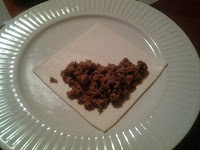Mmm! The delicious combination of meat and pastry! I don't know why the 2 go together so well, but it is a tried and tested formula. Think cornish pasties, calzones, Scotch pies, empanadas, sausage rolls or steak and kidney pies.
Forfar bridies originate, unsurprisingly, in Forfar in Scotland. There are several claims to the origins of the bridie but the most well known and accepted version is that they were invented by Margaret Bridie, a baker, in the 19th century and sold at the buttermarket in Forfar.
Forfar bridies can be made from either minced beef or strips of steak. Also the type of pastry used differs from place to place, either shortcrust pastry, which is preferred in Forfar, or flaky pastry in the rest of Scotland. Whether you choose to use mince or steak, and shortcrust or flaky pastry, the Forfar Bridie is a classic Scottish savoury recipe that will go down a treat!
Ingredients
(makes 12 bridies)
500g lean minced beef
1 large onion1 clove garlic
2 tsp English mustard
1 tsp paprika
1 tsp Marmite
1 tsp black pepper
1 beef stock cube
50g butter or beef suet
50ml milk or 1 egg - for glazing
12 sheets pre-rolled frozen shortcrust pastry*
*you can make your own pastry if you like, but the pre-rolled 10cm square sheets that you can buy here in Holland are perfect for these bridies. As always you have to balance out whether you can make the ingredient cheaper and better than buying from the shop.
Method
If using the pre-rolled sheets of pastry, set these aside on a table to defrost. This should take about 10 minutes.
Heat the butter or suet in a large frying pan, until it is melted and started to bubble. Fry the minced beef for approx 5 minutes turning as you go to ensure that all the meat is getting browned. It is always important when frying mince to cook thoroughly, to avoid nasty things like E Coli. The large surface area that the small mince pieces provides is a breeding ground for this and other bacterias. Brown your mince well.
Add the finely chopped onions and garlic to the pan, and continue frying for another 5 minutes. Add the spices, marmite and beef stock cube. If the mixture is a little too dry you can add a splash of water, but not too much or this will adversely affect the pies by making the pastry too wet. (Marmite and paprika are not traditional ingredients for Forfar bridies, but I find that they give an extra twang to the pies. Feel free to leave them out if you want to be authentic)
Preheat the oven to 200 C.
Ideally you want your filling mixture to have cooled slightly before making the pies. If you have time to do this, I would definitely recommend it.
Take one sheet of pastry and put it onto a plate in a diamond shape. Spoon some of the meat filling onto the bottom half of the pastry sheet, leaving a small edge around the side of the pastry (see photo 1).
 |
| Photo 1 |
Fold the top half of the pastry sheet carefully over the bottom half and press down the edges with your fingertips or a fork to seal the pastry - see photo 2.
 |
| Photo 2 |
Make a small slit in the top of the pastry to allow steam to escape during baking. Brush the pie with a little milk or beaten egg to glaze it and give it a nice golden brown colour.
Place the bridie onto a lightly oiled baking tray, or use greaseproof paper instead.
Repeat this same process with the rest of the pastry sheets and meat mixture.
Place the baking tray into the middle of the heated oven, and cook the bridies for about 30-35 minutes. They are ready when the pastry has risen and the pies are golden brown.
Serve immediately with roasted potatoes and vegetables. Beef gravy is a welcome condiment.
Enjoy!
DID YOU KNOW?
To avoid confusion, bakers will make 1 slit in the top of the bridie if it is without onions, and 2 slits if onions are included.
DID YOU KNOW?
Forfar bridies were made famous by the author, J M Barrie, the author of Peter Pan, in his short novel, Sentimental Tommy.


No comments:
Post a Comment
Note: only a member of this blog may post a comment.